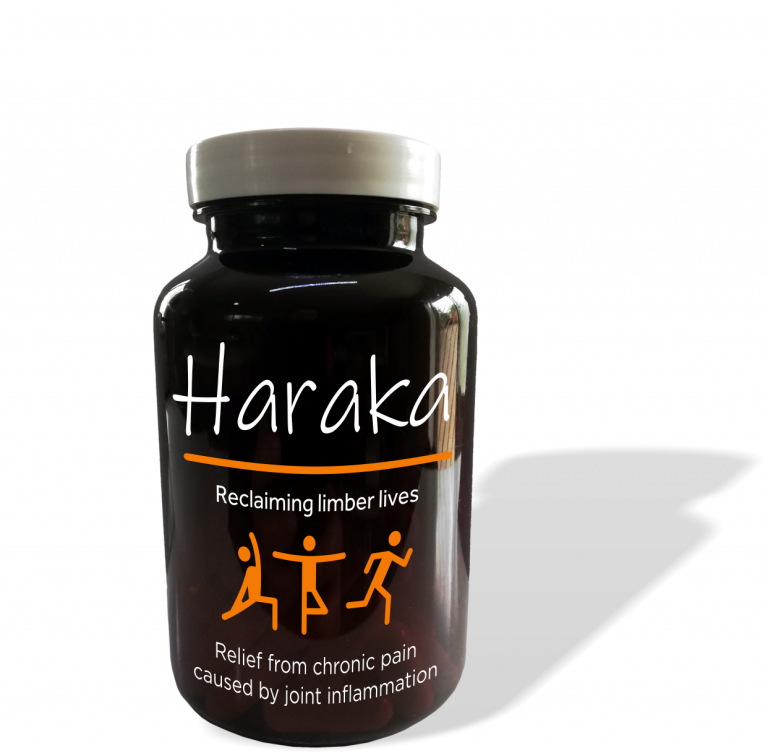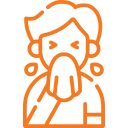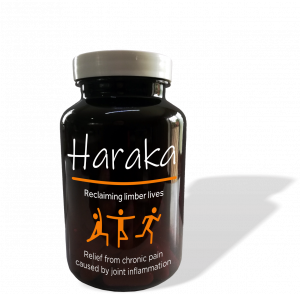About Haraka
Reclaiming limber lives
There are many herbs and plants that have therapeutic properties for reducing pain caused by inflammation – ranging from mild to highly potent efficacy. In some cases, it is relatively simple to extract and purify the active essence of the plant. In others, however, this process is difficult and costly. The higher the strength and potency, the more expensive the active element.
Haraka has been developed specifically for relief from pain caused by arthritic inflammation. Several factors were taken into consideration in its creation: Most of those afflicted with arthritis are likely over 60; many are already taking chronic medication for blood pressure regulation, diabetic conditions, cholesterol control, thyroid regulation, etc.; there is a high likelihood that many are either on scripted medication for blood thinning, or an OTC blood-thinning medication (e.g., baby aspirin); affordability in addition to efficacy.


The potency of Haraka’s anti-inflammatory, analgesic properties was intricately balanced with the risk factors when interacting with the above-mentioned medications.
These factors were all considered with thorough research and testing, resulting in the Haraka formulation.
Haraka delivers efficacy, potency, safety and affordability
Active ingredients in Haraka

BOSWELIA
Also known as Indian frankincense – from the Serrata tree.
Research has shown that boswellic acid can prevent the formation of leukotrienes (molecules triggering the production of prostaglandins); is effective in treating arthritic pain and inflammation; increases flexibility and reduces the levels of a cartilage-reducing enzyme; retards the loss of cartilage and bone.
Boswelia has immune-balancing properties which are effective as antioxidants in combatting free radicals.
Studies have also shown a reduction in the swelling of joints (rheumatoid arthritis and osteoarthritis) and an interference in the autoimmune process (rheumatoid arthritis).

DEVIL’S CLAW
Harpagophytum procumbens – known as the “hook plant” in Greek.
Although some North American plant species are referred to as a “devil’s claw”, it is only Harpagophytum procumbens, native to Namibia, that is believed to have medicinal properties. Used for centuries by the Koi San people to treat pain, arthritis, indigestion and skin conditions.
The active compound harpagoside in Devil’s Claw has powerful anti-inflammatory and analgesic (pain-relieving) properties.
It is used to treat rheumatic conditions affecting the joints, ligaments, tendons, bones, and muscles. These include back pain, osteoarthritis, rheumatoid arthritis, and tendinitis.
There is also strong belief that it is effective in the treatment of fibromyalgia, sciatica, nerve pain, gout, and some symptoms of Lyme disease.

BORON
A trace mineral found in leafy green vegetables, non-citrus fruits, grains, raisins, coffee.
Boron: Is essential for the growth and maintenance of bone; greatly improves wound healing; beneficially impacts the body’s use of oestrogen, testosterone, and vitamin D; boosts magnesium absorption; reduces levels of inflammatory biomarkers; raises levels of antioxidant enzymes; improves the brain’s electrical activity, cognitive performance, hand-eye co-ordination, and short-term memory.
Low levels of boron are correlated with higher levels of rheumatoid factor – the antibody that causes destruction of the joints in RA and OA.
What to expect from Haraka
The object of the Haraka formulation is to replace the need to take NSAID’s for the relief from inflammation, pain and stiffness caused by arthritis; to arrest the deterioration of joints; to regain a more limber lifestyle.


Haraka uses natural, herbal active ingredients and therefore the improvement – the corrections within the body – are gradual and gentle.
Therefore, there will be no dramatic effect immediately (as in the response to the properties of NSAID’s) but rather a low-risk adjustment of the body to the efficacy of the active herbs. For this reason, it is a good idea to keep a daily record of activity and response – a pattern will emerge, showing the gradual and sustained improvement.

Everyone will experience the improvement in different ways:
Nothing for a week or so, then intermittent days of total comfort followed by a day or two of the usual state, gradually the good days will outnumber the not-so-good days
Absolutely no improvement for a couple of weeks, then an almost “overnight” decrease in pain, increase in flexibility and comfort. which is sustained.
Very gradual improvement from the first week which is hardly noticeable, with no reverting to the former state. Only after a period of 6 – 8 weeks will the comparison be remarkable
How To Take Haraka
As you begin to feel the ongoing improvement, the tendency is often to do too much. Bear in mind that you have been favouring your sore joints for some time and putting excess pressure on them too quickly can often cause a reaction the following day. Therefore, increase your activity a little and see how your joints react and then do a bit more. Slow and steady increase in activity will ensure the sustained improvement.


Acute infections (e.g., ‘flu, sinus or bladder infections, a bad cold, etc.) can often cause all the previously painful joints to flare up. This is due to the body being under pressure to fight the new, immediate infections, drawing healing sources away from other non-essential conditions.
There is no reason to increase your daily dose of Haraka in these circumstances, continue as normal and everything will “calm down”. Likewise, if you should over-indulge (particularly with alcohol and sugar) your joints may react the following day but will recover within 24 hours.


Weather can affect arthritic joints. Despite the improvement and comfort derived from Haraka, if the weather suddenly turns very cold, wet, or windy, many people will feel it in the affected joints.
There is no natural or pharmaceutical medicine in the world that can claim it works exactly the same for every individual who uses it. Our bodies are unique and will respond and react differently to medicines.

In view of this, and the gentle work that the active extracts are doing within our body, it is necessary to be patient in expecting results. Some people feel the results within the first week, for others it could take up to 10 weeks. If you have any questions or concerns it is best to contact Gail directly (see Contact Information).
The Haraka formulation balances high potency with low risk and therefore there are no particularly cautionary notes. If, however, you would feel more comfortable checking with your medical practitioner before taking Haraka, the active ingredient specifications are listed below.
Ingredients
Devil’s Claw – 4.1 extract (origin: Harpagophytum procumbens DC)
Boswellia – 65% Boswellic Acid (origin: Boswellia Serrata)
Boron – Boron AAC 5%
Inactive raw materials

